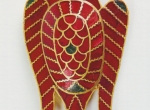Gepids
Gepids (Latin Gipedae, Gepidae), a Germanic people closely related to the →Goths . As with many →Germanic Tribes , the mythical homeland of the Gepids was Scandinavia (vagina nationum). The historian →Jordanes reports in his Getica that the Gepids set off from their homeland together with the →Goths and sailing southward across the Baltic Sea on three ships reached the land of Gothiskandza. One of the ships landed a little later than the others, which was said to give the tribe its name, from gepanta, meaning “slow, sluggish”. Some archaeologists attribute to the Gepids a part of →Wielbark Culture archaeological finds recorded in the region east of the Lower Vistula River, especially in the Elbląg Upland.
During the crisis of the Roman Empire of the 3rd century the Gepids, led by their king, Fastida, once again set off southward. During the 4th century their presence in the northern parts of Transylvania is confirmed in the archaeological record. At this time the Gepids defeated the →Burgundians and came into conflict with the →Ostrogoths .
From the 4th until mid-5th century the Gepids were under the domination of the →Huns , then ruled by →Attila. During the great Battle of the Catalaunian Plains (451) they sided with the →Huns and succumbed to the →Franks who fought on the side of the Roman commander Aëtius. After the death of Attila the Gepids moved into Transylvania where under the leadership of Ardaric they defeated the Huns in the Battle of Nedao (454 or 455). After this victory they established their kingdom in the territory east of the Tisza River, today’s eastern Hungary and western Romania. At this time they adopted a death rite characteristic for the Merovingian age, e.g., burial in row-grave cemeteries.
Finds from the territory settled by the Gepids include several deposits containing sumptuous dress accessories made of gold. One of their better known grave sites is the “princely” burial ground at Apahida in Romania with spectacular finds of e.g. gold jewellery in cloisonné technique decorated with almandines (Fig. 1).
In 488 the Gepids fought against the →Ostrogoths led by Theoderic, who with the permission from the Eastern Roman Emperor chose to attack Italy wishing to depose its ruler, Odoacer. The Gepid king Traustila was slain in these wars. In Pannonia the Gepids warred long against the →Langobards who had moved into the area in 526 settling in Pannonia west of the Danube. A major war between the Gepids and Langobards broke out in 549. Working behind the scenes was the Eastern Roman Emperor Justinian I who presumably wished to eliminate the Gepids as political players in the region to the north of his empire’s border. Justinian I officially gave his support to G. but in secret assisted the →Langobards. In 567 the latter allied themselves with nomad →Avars against the Gepids and led by their king Alboin annihilated them, even without assistance from the Avars to whom they nevertheless left the Gepid territory. After the →Langobards departed for Italy in 568 the Avars also moved into their territory to the west of the Danube. Most of the Gepids had joined the Langobards and migrated with them to Italy, the rest found themselves under Avar rule. By the late 6th century no traces of the tribe are to be found in the archaeological record.
JS
Literature: I. Bóna, M. Nagy, Gepidische Gräberfelder im Theissgebiet I, Budapest 2002; L. Börner, Ardarich und die Gepiden, [in:] Attila und die Hunnen. Begleitbuch zur Ausstellung des Historischen Museum der Pfalz, Speyer, Stuttgart 2007, p. 303-307; R. Danţă-Marghitu, The necroplis of Apahida (Romania), [in:] J.-J. Ailligon (ed.), Rome and the Barbarians. The Birth of a new World, Milano 2008, p. 280-283; P. Heather, Empire and Barbarians. Migration, Development and the Birth of Europe, Oxford-New York, 2010; M. Mączyńska, Świat z popiołu. Wędrówki ludów w Europie w IV i V wieku, Warszawa 2013.
-
 full resolution
full resolution
Fig. 1. A plaque in the shape of an eagle. Gold and almandines, from Danţă-Marghitu 2008.


